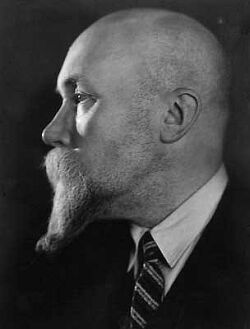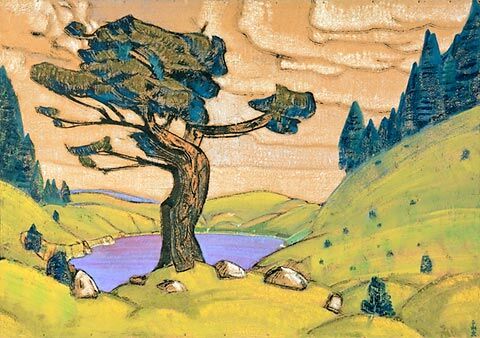Beard of the Week LXXXI: Pagan Russia
 This week's beard belongs to Nicholas Konstantinovich Roerich* (1874–1947), painter, lawyer, peace activist — any number of things, it seems. Excerpting some from biographical notes from the Nicholas Roerich Museum of New York
This week's beard belongs to Nicholas Konstantinovich Roerich* (1874–1947), painter, lawyer, peace activist — any number of things, it seems. Excerpting some from biographical notes from the Nicholas Roerich Museum of New York
Nicholas Konstantinovich Roerich was born in St. Petersburg, Russia, on October 9, 1874, the first-born son of lawyer and notary, Konstantin Roerich and his wife Maria. He was raised in the comfortable environment of an upper middle-class Russian family with its advantages of contact with the writers, artists, and scientists who often came to visit the Roerichs. At an early age he showed a curiosity and talent for a variety of activities. When he was nine, a noted archeologist came to conduct explorations in the region and took young Roerich on his excavations of the local tumuli. The adventure of unveiling the mysteries of forgotten eras with his own hands sparked an interest in archeology that would last his lifetime. […]
In 1895 Roerich met the prominent writer, critic, and historian, Vladimir Stasov. Through him he was introduced to many of the composers and artists of the time — Mussorgsky, Rimsky-Korsakov, Stravinsky, and the basso Fyodor Chaliapin. At concerts at the Court Conservatory he heard the works of Glazunov, Liadov, Arensky, Wagner, Scriabin, and Prokofiev for the first time, and an avid enthusiasm for music was developed. Wagner in particular appealed to him, and later, during his career as a theater designer, he created designs for most of that composer's operas. […]
The late 1890's saw a blossoming in Russian arts, particularly in St. Petersburg, where the avant-garde was forming groups and alliances, led by the young Sergei Diaghilev, who was a year or two ahead of Roerich at law school and was among the first to appreciate his talents as a painter and student of the Russian past.
This is the connection I was looking for this week because I wanted to note that we just passed an anniversary for the premiere of the ballet "The Rite of Spring" (originally "Le Sacre du Printemps"), subtitled "Pictures from Pagan Russia". It's notorious opening-night riot took place on 29 Mary 1913 at the Théâtre des Champs-Élysées, Paris.
The music, of course, was by Igor Stravinsky; choreography was by Vaslav Nijinsky; performance was by Les Ballets Russes. It was all produced by Serge Diaghilev. The original costumes and set designs were by Nicholas Roerich.
At first reading Roerich seemed to me an unlikely candidate for this activity, but the paragraphs above foreshadow it all: between his abiding interest in archeology and ancient (pagan) Russia, his growth as an artist, and his social connections among the liveliest of the artists working at the time, he was in the right place at the right time with the right ideas and talents, which strongly influenced the shape of the final work. As Wikipedia tells the story of the ballet's genesis:
The painter Nicholas Roerich shared his idea with Stravinsky in 1910, his fleeting vision of a pagan ritual in which a young girl dances herself to death. Stravinsky's earliest conception of The Rite of Spring was in the spring of 1910, in the form of a dream: "… the wise elders are seated in a circle and are observing the dance before death of the girl whom they are offering as a sacrifice to the god of Spring in order to gain his benevolence," said Stravinsky. While composing The Firebird, Stravinsky began forming sketches and ideas for the piece, enlisting the help of Roerich.
The result was not only history, but historic. "The Rite of Spring" endures as a musical masterpiece of the ages, not just the twentieth century, as perhaps the most original and creative piece of musical writing ever. I find it perennially amazing and fresh. Plus, as Bernstein once said, it's "got the best dissonances anyone ever thought up".
And now I'm finding that Roerich is a fascinating person whom I have to investigate further. As one example of his artistic style, here is one of the set designs he did for the Diaghilev production of "Rite", a painting called "Kiss to the Earth (variant 1)", probably implemented as a painted drop.

For a nice collection of paintings by Roerich and his sons, visit the gallery of the Estonian Roerich Society. There are also museums with information and images online: The Nicholas Roerich Museum New York, The Museum by Name of Nicholas Roerich, in Moscow.
Also while I was looking for information, I found this curious article called "Utopia on the Roof of the World" from the magazine Cabinet. The article had something to do with the Shambhala myth and Buddhism, or something, but I read through it and could make much sense of it. However, at the top of the page is a beautiful portrait of Nicholas Roerich by his son Svetoslav Roerich. Apparently Roerich believe Shambhala was located in the Himalayan mountains.
So now I'm interested in knowing why so many people are interested in Nicholas Roerich.
———-
* Photo credit: Nicholas Roerich Museum (of New York), link; original caption: "Nicholas Roerich. June 20, 1929. New York / NRM ref. No 400926"
2 Responses
Subscribe to comments via RSS
Subscribe to comments via RSS
Leave a Reply
To thwart spam, comments by new people are held for moderation; give me a bit of time and your comment will show up.
I welcome comments -- even dissent -- but I will delete without notice irrelevant, rude, psychotic, or incomprehensible comments, particularly those that I deem homophobic, unless they are amusing. The same goes for commercial comments and trackbacks. Sorry, but it's my blog and my decisions are final.

on Tuesday, 9 June 2009 at 17.35
Permalink
What a fascinating man! And a great beard!
I'll have to search for more on him. I'm trusting he made it out of Russia before the Revolution?
on Thursday, 11 June 2009 at 21.10
Permalink
This is an amazing post. What a life! The connection to The Rite of Spring is intriguing as well. Great collection of links that I will have to explore. Thanks for the research!